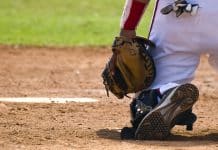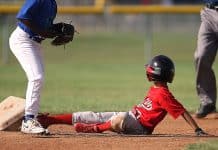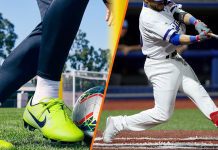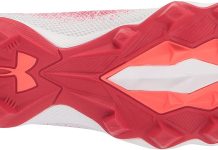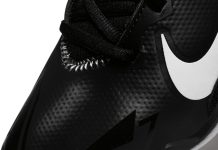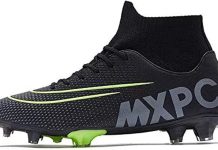When it comes to choosing the right kind of footwear for the game, high school baseball players are faced with a decision that can greatly impact their performance on the field. The type of cleats they choose can make a world of difference in terms of traction, stability, and overall comfort. From metal to molded, there are various options available that cater to the specific needs of these young athletes. In this article, we will explore the different types of cleats commonly used by high school baseball players, helping you make an informed choice for your own game.
Factors to consider when choosing baseball cleats
When choosing baseball cleats, there are several important factors that you should consider. These factors will not only affect your performance on the field but also your overall comfort and safety. By understanding these factors, you can make an informed decision and select the perfect pair of cleats for your needs.
Review contents
Playing surface
One of the first factors to consider is the type of playing surface you will be playing on. Different surfaces require different types of cleats to provide the best traction and performance. The three main types of playing surfaces in baseball are grass, turf, and dirt. Grass fields typically require molded or metal cleats, while turf fields require turf cleats. Dirt fields can accommodate any type of cleats. It is essential to choose cleats that are specifically designed for the playing surface you will be using most frequently.
Position
Another factor to consider is the position you play on the baseball field. Different positions have varying demands and require specific features in cleats. For example, pitchers may prefer cleats with excellent traction and stability to enhance their throwing motion, while outfielders may value cleats that provide superb acceleration and speed. Infielders often benefit from cleats that offer quick lateral movements and agility. By considering your position, you can choose cleats that are tailored to meet the specific requirements of your role on the field.
Fit
The fit of your baseball cleats is crucial for your comfort and performance. Ill-fitting cleats can cause discomfort, blisters, and even foot injuries. It is essential to try on different cleats and find a pair that provides a snug yet comfortable fit. Look for cleats that have enough room in the toe box to prevent crowding and potential injury. Additionally, consider the width and arch support of the cleats to ensure optimal comfort throughout the game.
Materials
The materials used in the construction of baseball cleats can greatly impact their durability, performance, and overall feel. Common materials used in cleats include leather, synthetic materials, and mesh. Leather cleats are known for their durability and flexibility, while synthetic cleats often offer a lightweight and breathable option. Mesh cleats provide excellent ventilation and are ideal for players who prioritize breathability. Consider your personal preferences and the level of durability required for your playing style when choosing the material of your cleats.
Style
While style may not directly impact your performance on the field, it is still an important factor for many players. Choosing a pair of cleats that you find aesthetically appealing can boost your confidence and overall enjoyment of the game. Many sporting goods brands offer a wide range of colors and designs, allowing you to personalize your look on the field. However, it is important to remember that style should not be the sole determining factor when choosing baseball cleats. Prioritize the functional aspects of the cleats first to ensure the best performance and safety.
Different types of baseball cleats
Now that we have discussed the factors to consider when choosing baseball cleats, let’s explore the different types of baseball cleats available on the market. Each type has its own advantages and disadvantages, so understanding their features can help you make an informed decision when purchasing your next pair of cleats.
Molded cleats
Molded cleats, also known as plastic cleats, are a popular choice among baseball players, especially those who play on grass fields. These cleats feature plastic studs or spikes that are permanently attached to the sole of the shoe. One of the main advantages of molded cleats is their versatility; they can be used on various playing surfaces, including grass, dirt, and turf. They offer good traction and stability while remaining lightweight. Additionally, molded cleats are often more affordable compared to other types of cleats. However, they may not provide the same level of traction as metal cleats on very soft or wet grass fields.
Metal cleats
Metal cleats, also referred to as screw-in cleats, are a popular choice for players who prioritize maximum traction and stability. As the name suggests, these cleats have metal spikes that can be screwed into the sole of the shoe. Metal cleats provide excellent grip and traction on grass fields, making them ideal for players who require quick bursts of speed and agility. They also offer superior durability compared to molded cleats. However, it’s important to note that metal cleats are not allowed in some leagues or age groups due to safety concerns. Always check the rules and restrictions of your league before using metal cleats.
Turf cleats
Turf cleats, also known as turf shoes, are specifically designed for synthetic turf playing surfaces. These cleats feature short rubber studs or nubs that provide optimal traction and grip on turf. Turf cleats are known for their low profile and lightweight design, making them comfortable for extended periods of play. They are also versatile and can be used on other surfaces such as concrete or indoor courts, making them a popular choice for players who participate in multiple sports. However, turf cleats are not suitable for grass or dirt fields as they do not provide the same level of traction and stability.
Interchangeable cleats
Interchangeable cleats, as the name implies, allow players to switch between different types of cleats depending on the playing surface. These cleats feature a sole with receptacles that can accommodate different types of studs or spikes. This versatility is particularly beneficial for players who frequently play on different surfaces or want the option to customize their traction. However, it’s important to note that interchangeable cleats tend to be pricier compared to other types of cleats. Additionally, the process of changing the cleats requires time and effort, so it may not be ideal for quick transitions between games.
Molded cleats
Now let’s delve deeper into the characteristics and features of molded cleats.
Description
Molded cleats, as mentioned earlier, are baseball cleats with plastic studs or spikes that are molded directly into the outsole of the shoe. These studs are evenly distributed throughout the sole, providing consistent traction on the playing surface.
Advantages
There are several advantages to choosing molded cleats. Firstly, they are more versatile compared to other types of cleats, as they can be used on various playing surfaces, including grass, dirt, and turf. This versatility makes molded cleats a popular choice among players who participate in multiple leagues or frequently transition between different fields.
Molded cleats also tend to be more affordable compared to metal cleats or interchangeable cleats. They offer a cost-effective option for players on a budget or those who are just starting with baseball and do not want to invest in pricier cleats.
Additionally, molded cleats are lightweight and comfortable. They often provide a more cushioned feel due to the absence of metal components in the outsole. The lightweight construction allows for quick movements and reduces fatigue during long games or practices.
Disadvantages
While molded cleats have many advantages, they also have a few disadvantages that players should consider. One of the main drawbacks is the level of traction they provide on soft or wet grass fields. Due to the plastic studs, molded cleats may not grip the ground as effectively as metal cleats, which can impact acceleration, deceleration, and lateral movements. In situations where the playing surface is extremely muddy or slippery, metal cleats may offer better traction.
Another disadvantage of molded cleats is their limited customization. Unlike interchangeable cleats, molded cleats have fixed studs that cannot be adjusted or changed. This means that you cannot modify the stud length or shape to suit your specific playing preferences or field conditions.
Metal cleats
Metal cleats are highly favored by many baseball players, particularly those who play on grass fields and prioritize maximum traction and stability.
Description
Metal cleats feature metal spikes that can be screwed into the shoe’s sole. These spikes are typically made of steel or other durable metals. Metal cleats are known for their excellent grip on grass fields, as the sharp spikes can penetrate the ground, providing superior traction and preventing slippage.
Advantages
One of the key advantages of metal cleats is their exceptional traction. The metal spikes allow for a strong grip on the grass, enabling quick sprints, sharp turns, and precise movements. This is particularly important for players involved in positions where agility and speed play a crucial role, such as outfielders and base stealers.
Metal cleats are also highly durable. The metal spikes are designed to withstand the stress and friction of repeated use, making them a long-lasting option. This durability can be advantageous for players who play frequently or participate in rigorous training sessions.
Disadvantages
Despite their advantages, metal cleats have a few drawbacks that players should consider. Firstly, they tend to be more expensive than other types of cleats. This higher cost is due to the additional materials and manufacturing processes involved in creating metal cleats. If you are on a limited budget, metal cleats may not be the most cost-effective option.
Another potential disadvantage of metal cleats is the rules and restrictions associated with their use. Some leagues or age groups do not allow metal cleats due to safety concerns. The sharp metal spikes can pose a risk of injury to other players, especially during sliding or contact plays. Always check the regulations of your league before using metal cleats to avoid potential penalties or disqualification.
Turf cleats
Turf cleats, also known as turf shoes, are specifically designed for synthetic turf playing surfaces.
Description
Turf cleats feature short rubber studs or nubs that evenly cover the sole of the shoe. These studs are shallower and wider compared to the spikes found on other types of cleats. This design allows turf cleats to provide optimal traction and grip on turf surfaces while preventing damage to the synthetic grass.
Advantages
One of the main advantages of turf cleats is their suitability for synthetic turf. The rubber studs or nubs offer excellent traction on these surfaces, allowing players to make quick movements and cuts without slipping. The shallow and wide design of the studs ensures that the turf’s integrity is maintained, preventing any potential damage.
Turf cleats are also known for their versatility. They can be used on various playing surfaces beyond turf, such as concrete or indoor courts. This versatility makes them an ideal choice for players who participate in multiple sports or train on different surfaces.
Additionally, turf cleats tend to be more comfortable compared to other types of cleats. The rubber studs or nubs offer a cushioned feel and generally provide better shock absorption, reducing the impact on your feet and joints during high-impact movements.
Disadvantages
While turf cleats have several advantages, they also have a few disadvantages. One of the main drawbacks is their limited use on non-turf surfaces. Due to the design of the rubber studs or nubs, turf cleats may not provide adequate traction on grass or dirt fields. If you frequently play on different surfaces, or if your league uses various playing fields, turf cleats may not be the most suitable option.
Another potential disadvantage is the reduced ankle support offered by turf cleats. The low-profile design of these cleats, while enhancing comfort and mobility, may not provide the same level of ankle stabilization as cleats with higher collars. Consider your specific needs for ankle support and stability when choosing turf cleats.
Interchangeable cleats
Interchangeable cleats are a versatile option that allows players to switch between different types of cleats depending on the playing surface and their specific needs.
Description
Interchangeable cleats feature a sole with receptacles or ports where different types of studs or spikes can be inserted. The studs or spikes can be easily screwed in or out, allowing players to customize their traction and performance based on the conditions of the playing surface.
Advantages
The primary advantage of interchangeable cleats is their versatility. By providing the option to change studs or spikes, players can adjust their cleats to suit the specific demands of different playing surfaces. This versatility is particularly beneficial for players who frequently transition between different fields or participate in various leagues.
Interchangeable cleats also offer customization options. Depending on the manufacturer and model, you may have the ability to choose between different lengths, shapes, and materials of studs or spikes. This customization allows you to fine-tune your cleats to match your playing style or field conditions, ultimately enhancing your performance on the baseball field.
Disadvantages
Despite their advantages, interchangeable cleats have a few disadvantages to consider. The main drawback is their higher price compared to other types of cleats. The additional components and mechanisms required to accommodate the interchangeable feature contribute to the increased cost. If you have a limited budget, interchangeable cleats may not be the most affordable option.
Another potential disadvantage is the time and effort required to change the studs or spikes. Compared to other types of cleats that have fixed studs, interchangeable cleats require extra steps to replace or adjust the studs. This process may not be ideal for quick transitions between games or practices. It is important to weigh the benefits of customization and versatility against the inconvenience of the additional maintenance and preparation required.
Popular brands for high school baseball cleats
Now that we have explored the different types of cleats, let’s take a look at some popular brands known for producing high-quality baseball cleats for high school players.
Nike
Nike is a well-respected brand in the world of sports, and their baseball cleats are no exception. Nike offers a wide range of cleats designed to cater to different playing styles and preferences. They are known for their innovative designs, durability, and excellent traction. Nike cleats often incorporate advanced technologies, such as responsive cushioning and breathable materials, to enhance comfort and performance on the field.
New Balance
New Balance is another popular brand that produces reliable and high-performing baseball cleats. Their cleats are designed with player input, ensuring that they meet the specific needs of baseball players. New Balance cleats often feature a comfortable fit, excellent traction, and superior durability. The brand offers various models to accommodate different playing positions and surface types, allowing players to find the perfect pair of cleats for their requirements.
Under Armour
Under Armour is known for its commitment to providing athletes with high-quality gear, and their baseball cleats are no exception. Under Armour offers cleats that prioritize lightweight performance, durability, and exceptional traction. Their cleats often incorporate innovative technologies, such as breathable materials, responsive cushioning, and lateral stability features, to enhance player comfort and on-field performance.
Adidas
Adidas is a prominent brand in the world of sports, and their baseball cleats are highly regarded by many players. Adidas cleats are known for their sleek designs, excellent traction, and durability. The brand offers a wide range of cleats catering to different positions and playing surfaces. Adidas cleats often incorporate advanced technologies, such as lightweight materials, superior cushioning, and support systems, to optimize player performance and comfort.
Mizuno
Mizuno is a brand that is synonymous with quality and craftsmanship. Their baseball cleats are carefully designed and manufactured to provide optimal performance and durability. Mizuno cleats are known for their excellent fit, traction, and comfort. The brand offers cleats that cater to various playing styles and preferences. Many players appreciate Mizuno’s attention to detail and commitment to creating cleats that enhance performance while keeping players comfortable throughout the game.
Considerations for high school players
As a high school baseball player, there are a few additional factors to consider when choosing the perfect pair of cleats for your needs.
Budget
Budget is an important consideration for many high school players. While it is tempting to go for the most expensive and high-end cleats, it’s essential to find a balance between quality and cost. Consider your budget and look for cleats that offer a good combination of performance, durability, and affordability. Remember, a higher price tag does not always guarantee better performance or comfort.
Personal preference
Personal preference plays a significant role in selecting baseball cleats. Each player has unique preferences when it comes to fit, style, and feel. It’s crucial to try on different cleats and assess how they feel on your feet. Pay attention to the overall comfort, the fit around the toes, the arch support, and any potential pressure points. Choose cleats that feel comfortable and provide the necessary support for your playing style and foot structure.
Durability
Durability is an important consideration, especially for high school players who participate in frequent practices and games. Look for cleats that are made with high-quality materials and sturdy construction to ensure they can withstand the wear and tear of intense play. Check reviews and ask for recommendations to get an idea of how well specific cleats hold up over time.
Comfort
Comfort is essential to perform at your best on the field. Look for cleats that provide a snug, yet comfortable fit. Consider features like cushioning, breathability, and support systems. Cleats with responsive cushioning can help absorb impact and reduce stress on your feet and joints. Breathable materials can enhance airflow and prevent excessive sweating. Support systems, such as arch support or ankle support, can provide extra stability and prevent injuries. Prioritize comfort alongside performance to ensure you can focus on the game without any discomfort or distraction.
Proper care and maintenance
To make the most out of your baseball cleats and ensure their longevity, it’s essential to take proper care of them. Here are some important care and maintenance tips to keep your cleats in good condition:
Cleaning
Regularly clean your cleats after each game or practice to remove dirt, grass stains, and mud. Use a soft brush or cloth and mild soap or detergent. Gently scrub the surface of the cleats, paying extra attention to the soiled areas. Avoid using harsh chemicals or abrasive materials that can damage the materials or finishes of the cleats.
Drying
After cleaning, allow your cleats to air dry naturally. Do not use direct heat sources, such as heaters or dryers, as excessive heat can deform or damage the materials. Stuff the inside of the cleats with newspaper or paper towels to absorb moisture and help maintain their shape.
Storage
When not in use, store your cleats in a cool and dry place. Avoid leaving them in direct sunlight or extreme temperatures, as these conditions can cause the materials to deteriorate. Consider using a shoe bag or box to protect the cleats from dust and potential scuffs.
By following these care and maintenance practices, you can extend the lifespan of your baseball cleats and ensure that they continue to perform at their best throughout the season.
Importance of well-fitting cleats
Wearing well-fitting cleats is crucial for both your performance and safety on the baseball field. Here are a few reasons why well-fitting cleats are important:
Injury prevention
Ill-fitting cleats can increase the risk of foot and ankle injuries. When your cleats are too loose or too tight, they can cause blisters, abrasions, or even sprains. Tight cleats can restrict blood circulation and increase pressure on certain areas of the feet, leading to discomfort and potential injuries. On the other hand, loose cleats can cause instability and create an unstable platform for your movements, increasing the risk of tripping or twisting your ankle. By wearing properly fitting cleats, you can reduce the likelihood of these injuries and stay on the field performing at your best.
Performance enhancement
Well-fitting cleats can enhance your performance on the baseball field. Cleats that provide a snug yet comfortable fit allow for better control, stability, and agility. A secure fit ensures that your foot and cleat function as one unit, allowing for more precise and powerful movements. Properly fitting cleats can also optimize your acceleration, deceleration, and quick changes in direction, giving you that competitive edge. Additionally, comfortable cleats that fit well can improve your overall focus and confidence, enabling you to fully concentrate on the game without distractions or discomfort.
In conclusion, choosing the right baseball cleats requires careful consideration of factors such as playing surface, position, fit, materials, and style. Molded cleats offer versatility and affordability, while metal cleats provide exceptional traction and durability. Turf cleats are suitable for synthetic turf surfaces, and interchangeable cleats allow for customization and adaptability. Popular brands for high school players include Nike, New Balance, Under Armour, Adidas, and Mizuno. High school players should consider budget, personal preference, durability, and comfort when selecting cleats. Proper care and maintenance, including cleaning, drying, and storage, are essential to prolong the lifespan of cleats. Finally, wearing well-fitting cleats is crucial for injury prevention and performance enhancement. By keeping these factors in mind, you can choose the perfect pair of baseball cleats and step onto the field with confidence.




